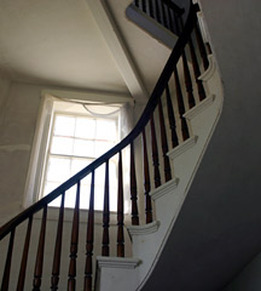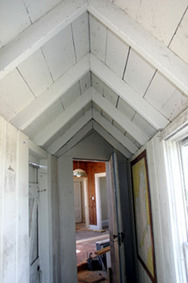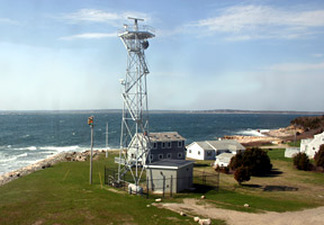History of Wings Neck Light, Pocasset, Massachusetts
© Jeremy D'Entremont. Do not reproduce any part of this website without permission of the author.
The peninsula called Wing's Neck extends from Pocasset on Cape Cod out into Buzzards Bay, a busy thoroughfare in the nineteenth century. The land where the lighthouse is located was once swampy and mosquito-infested.
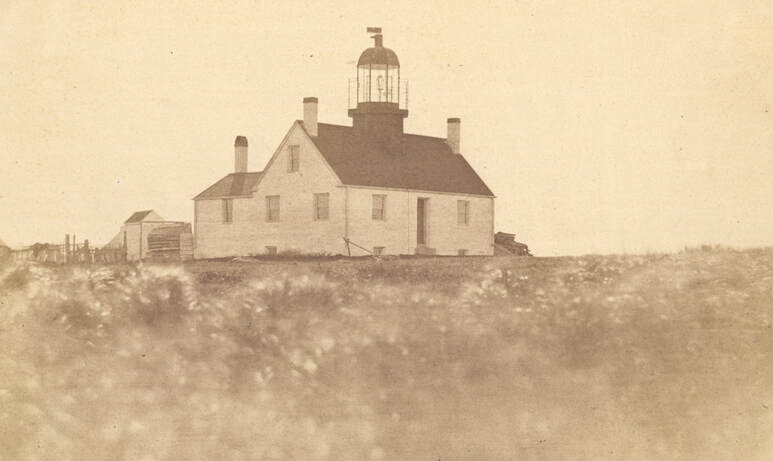
The first Wings Neck Lighthouse (National Archives)
Congress first appropriated $5,000 for a lighthouse at the tip of Wing's Neck in 1837, but the project was delayed after some debate about whether the light was really needed.
There was plentiful iron ore in the area's swampy terrain, and several foundries -- including the Pocasset Iron Company -- were established by the mid-1800s. These businesses added volume to the local shipping traffic, with many vessels traveling to and from Sandwich and Wareham, to the northwest. As maritime traffic in the vicinity increased, Congress appropriated $3,500 for a lighthouse in August 1848.
The first lighthouse, built in 1849 for $3,251, was a so-called Cape Cod-style structure, with a white, wooden hexagonal tower and lantern room on top of a stone keeper's house. The light was 38 feet above the ground and 50 feet above the water. In the 1870s, it was reported that the weight of the lantern was crushing the roof of the dwelling.
There was plentiful iron ore in the area's swampy terrain, and several foundries -- including the Pocasset Iron Company -- were established by the mid-1800s. These businesses added volume to the local shipping traffic, with many vessels traveling to and from Sandwich and Wareham, to the northwest. As maritime traffic in the vicinity increased, Congress appropriated $3,500 for a lighthouse in August 1848.
The first lighthouse, built in 1849 for $3,251, was a so-called Cape Cod-style structure, with a white, wooden hexagonal tower and lantern room on top of a stone keeper's house. The light was 38 feet above the ground and 50 feet above the water. In the 1870s, it was reported that the weight of the lantern was crushing the roof of the dwelling.
The first keeper, Edward Doty Lawrence, was removed in 1854 for belonging to the wrong political party.
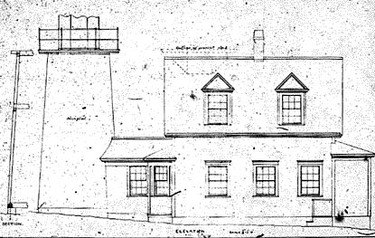
Plans for Wing's Neck Lighthouse (1890). U.S. Coast Guard
Lawrence returned as keeper in 1865 and remained until 1887, serving a total of 28 years at Wing's Neck. Lawrence's daughter, Caroline, was later married to Keeper Albert Gifford. (Thanks to Fleming Wright for this information.)
John Maxim, who was keeper in the 1850s, was killed at the Battle of Gettysburg.
The Lighthouse Board reported in 1857 that a fourth-order Fresnel lens had replaced the earlier system of multiple lamps and reflectors. In 1928, the lens was replaced and the light was changed from fixed to flashing. The light was converted to electricity in 1934.
John Maxim, who was keeper in the 1850s, was killed at the Battle of Gettysburg.
The Lighthouse Board reported in 1857 that a fourth-order Fresnel lens had replaced the earlier system of multiple lamps and reflectors. In 1928, the lens was replaced and the light was changed from fixed to flashing. The light was converted to electricity in 1934.
The building was in poor condition by 1878, as is reflected in the annual report that year:
The roof of the dwelling was repaired temporarily, and new gutters supplied. There is no tower at this station. The lantern is on top of the dwelling, the roof has been crushed, and a great part of the interior of the house is occupied by the stairway. A tower is required, and the dwelling should be extensively repaired.
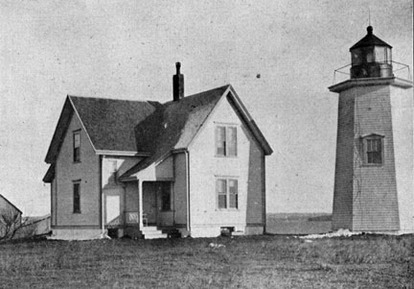
A fire did further damage to the building later that year, but repairs sufficed until 1888, when funds were finally appropriated to rebuild the station.
The new dwelling, completed in 1890 on the original foundation, was a wood-frame structure, 28 by 31 feet.
A hexagonal wooden lighthouse tower was erected next to the dwelling, with the light 44 feet above the water; the two structures were connected by an enclosed walkway in 1899.
A pyramidal wooden bell tower and a 1,000-pound fog bell were added to the station in 1902.
The new dwelling, completed in 1890 on the original foundation, was a wood-frame structure, 28 by 31 feet.
A hexagonal wooden lighthouse tower was erected next to the dwelling, with the light 44 feet above the water; the two structures were connected by an enclosed walkway in 1899.
A pyramidal wooden bell tower and a 1,000-pound fog bell were added to the station in 1902.
Albert Gifford served as keeper at Wing's Neck for 21 years, beginning in 1887. His wife, Caroline (Carry) H. Gifford, served as his assistant.
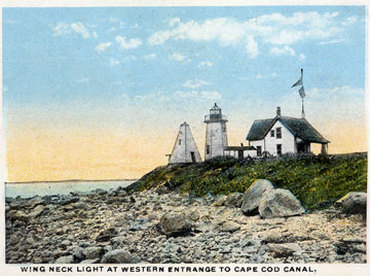
Edward D. Nickerson, the local undertaker, described what happened the night Albert Gifford died at the lighthouse in October 1908:
One mean and foggy night he died in his house. I hitched up my old nag and drove down there. Mrs. Gifford was alone [and] as I worked on his body, she carried on through that beastly, cold, foggy, night, tending the light and clocking the fog bell. After finishing my work I stayed the night there. I could not leave her way out there alone with her husband lying dead in the parlor.
The light streaming out into the foggy night and the weird clang-clang-clang of that great bell every 1/2-minute. I never forgot that night or the woman all alone there sticking to her husband's responsible job.
One mean and foggy night he died in his house. I hitched up my old nag and drove down there. Mrs. Gifford was alone [and] as I worked on his body, she carried on through that beastly, cold, foggy, night, tending the light and clocking the fog bell. After finishing my work I stayed the night there. I could not leave her way out there alone with her husband lying dead in the parlor.
The light streaming out into the foggy night and the weird clang-clang-clang of that great bell every 1/2-minute. I never forgot that night or the woman all alone there sticking to her husband's responsible job.
Carry Gifford was keeper for two weeks before being relieved by Wallace Eldredge, son of a Nantucket whaler. Eldredge earned five Efficiency Gold Stars for excellent service during his years at Wing's Neck.
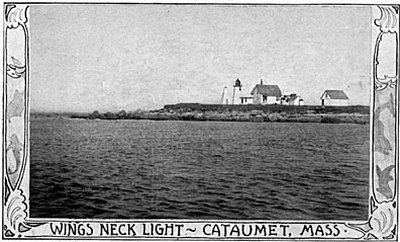
After the opening of the Cape Cod Canal in 1914, with the its western entrance just a few miles northeast of Wing's Neck, the local maritime traffic greatly increased.
Personnel at the light station had to watch for any vessel approaching the canal from the south, and they would telephone word ahead so that a tugboat and pilot could meet the vessel for its passage through the canal.
For a time, the keeper's wife, Louise Eldredge served as the official day dispatcher for the canal. She also had the duty of flying storm signal flags at the station as needed.
Personnel at the light station had to watch for any vessel approaching the canal from the south, and they would telephone word ahead so that a tugboat and pilot could meet the vessel for its passage through the canal.
For a time, the keeper's wife, Louise Eldredge served as the official day dispatcher for the canal. She also had the duty of flying storm signal flags at the station as needed.
President Harding once passed near the station in the Presidential yacht Mayflower. Because of bad weather, the yacht anchored near Wing's Neck. In the morning Keeper Eldredge gave the President a "twenty-one gun salute" with the fog bell.
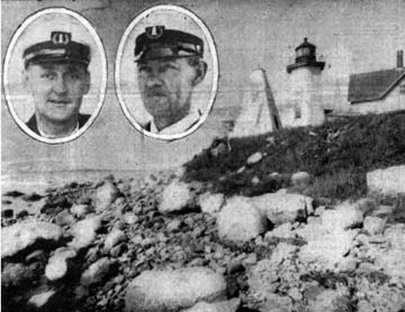
George and William Howard
George Addison Howard, formerly at several other Massachusetts light stations, became keeper in 1921. His brother, William, previously at Boston Light, was his assistant. The sons of the captain of the Cross Rip Lightship in Vineyard Sound, the Howard brothers gained widespread fame as lifesavers.
In one instance, on July 14, 1931, a small boat overturned with a man and four young boys on board, and William Howard went out in the station's boat and rescued all five. In 1932 alone the Howard brothers were credited with eight lives saved.
"I wish they wouldn't go off here fishing or cruising in such small craft," said William Howard, "If it comes up a quick blow there's sure to be trouble." By the end of William Howard's career it was estimated that he had saved 37 people.
In one instance, on July 14, 1931, a small boat overturned with a man and four young boys on board, and William Howard went out in the station's boat and rescued all five. In 1932 alone the Howard brothers were credited with eight lives saved.
"I wish they wouldn't go off here fishing or cruising in such small craft," said William Howard, "If it comes up a quick blow there's sure to be trouble." By the end of William Howard's career it was estimated that he had saved 37 people.
In 1923, the keeper's house at Ned's Point Light in Mattapoisett was floated across Buzzards Bay to become an assistant keeper's house at Wing's Neck Light Station. The house is now privately owned.
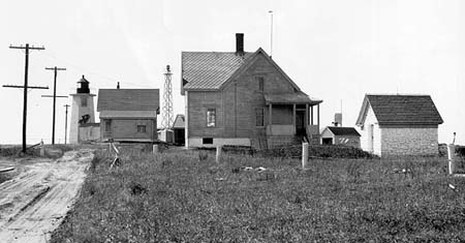
This U.S. Coast Guard photo shows both keeper's houses at Wing's Neck
With the building of Cleveland Ledge Light, Wing's Neck Light was considered expendable. The station was discontinued in 1945 and went up for sale in 1947. It was bought by Frank and Irene Flanagan of Boston for $13,738.
The Flanagans were a musical family and Wing's Neck Light became a center of musical activity in the area. Their daughter, Beth, was a concert pianist; when she was married Beth threw her bouquet from the top of the lighthouse tower. Barbershop quartet concerts frequently took place on the lawn, and the von Trapp family singers of Sound of Music fame spent some time at the lighthouse. Irene Flanagan lived at the lighthouse until recent years; she died in 1999 at the age of 96.
The Flanagans were a musical family and Wing's Neck Light became a center of musical activity in the area. Their daughter, Beth, was a concert pianist; when she was married Beth threw her bouquet from the top of the lighthouse tower. Barbershop quartet concerts frequently took place on the lawn, and the von Trapp family singers of Sound of Music fame spent some time at the lighthouse. Irene Flanagan lived at the lighthouse until recent years; she died in 1999 at the age of 96.
The area around the lighthouse is a monitoring station for the Cape Cod Canal, with radar and a closed circuit television system.
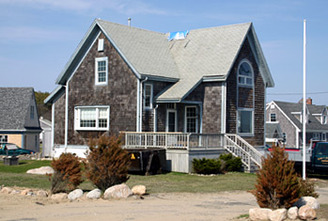
Right: This house was originally built in Mattapoisett at Ned's Point Light where it served as a keeper's house, but it was moved to Wing's Neck in 1923. Today it's a private home.
Wing's Neck Light is on private property and the grounds are not accessible to the public. It can be viewed from a gate about 100 yards from the lighthouse. The lighthouse is available for rent; for more information contact the Wing's Neck Lighthouse Trust.
Wing's Neck Light is on private property and the grounds are not accessible to the public. It can be viewed from a gate about 100 yards from the lighthouse. The lighthouse is available for rent; for more information contact the Wing's Neck Lighthouse Trust.
Keepers: (This list is a work in progress. If you have any information on the keepers of this lighthouse, I'd love to hear from you. You can email me at [email protected]. Anyone copying this list onto another web site does so at their own risk, as the list is always subject to updates and corrections.)
Edward Doty Lawrence (1849-1854 and 1865-1887); Samuel Barlow (1854-1859); A. Wright (1859-1861); William King (1861-1865); John Hogan (1887); Albert Gifford (1887-1908, died in service); Carry H. Gifford (1908); Wallace A. Eldredge (1908-1921); George Howard (1921-1937); William Howard, assistant (1920s).
Edward Doty Lawrence (1849-1854 and 1865-1887); Samuel Barlow (1854-1859); A. Wright (1859-1861); William King (1861-1865); John Hogan (1887); Albert Gifford (1887-1908, died in service); Carry H. Gifford (1908); Wallace A. Eldredge (1908-1921); George Howard (1921-1937); William Howard, assistant (1920s).
